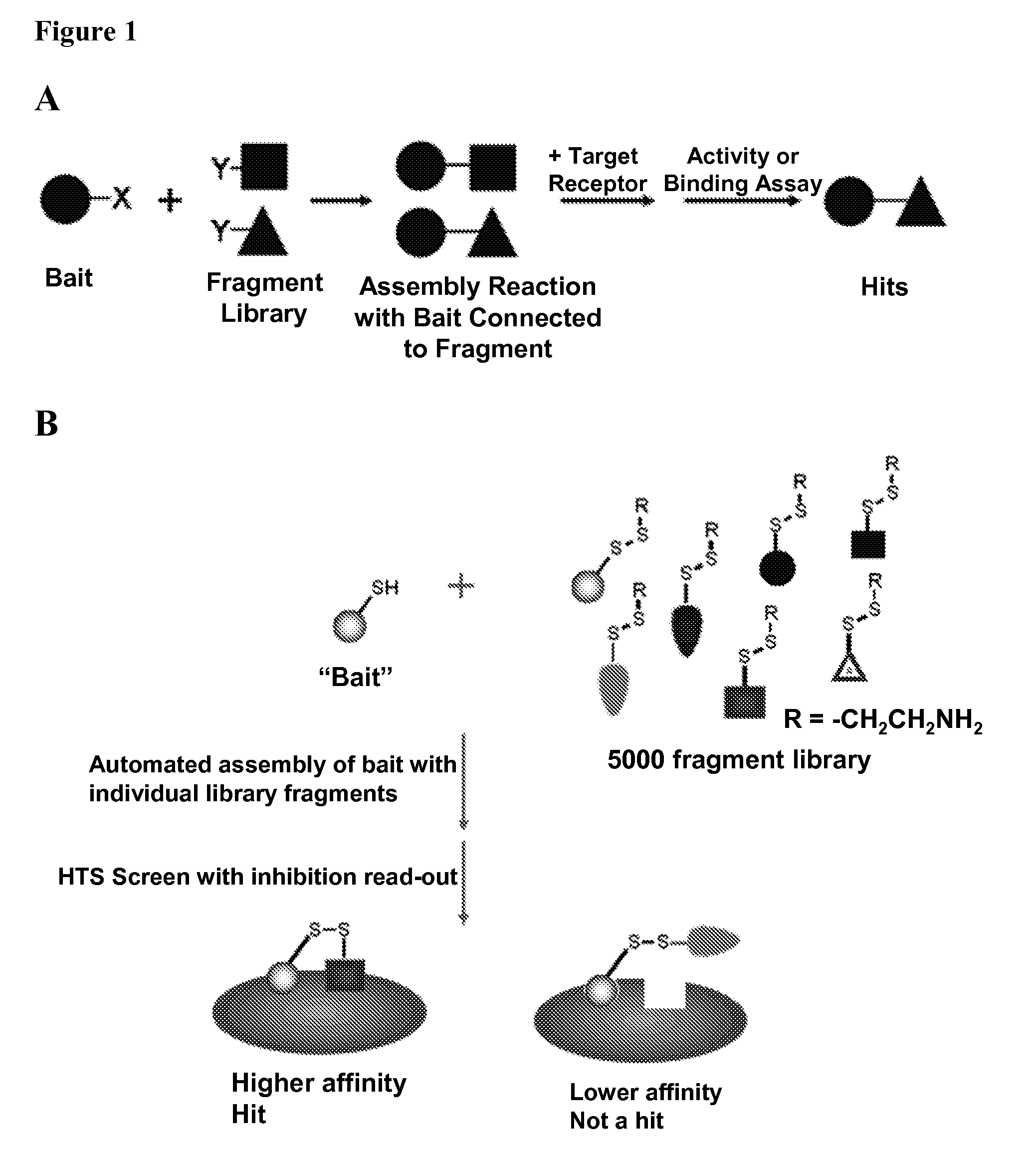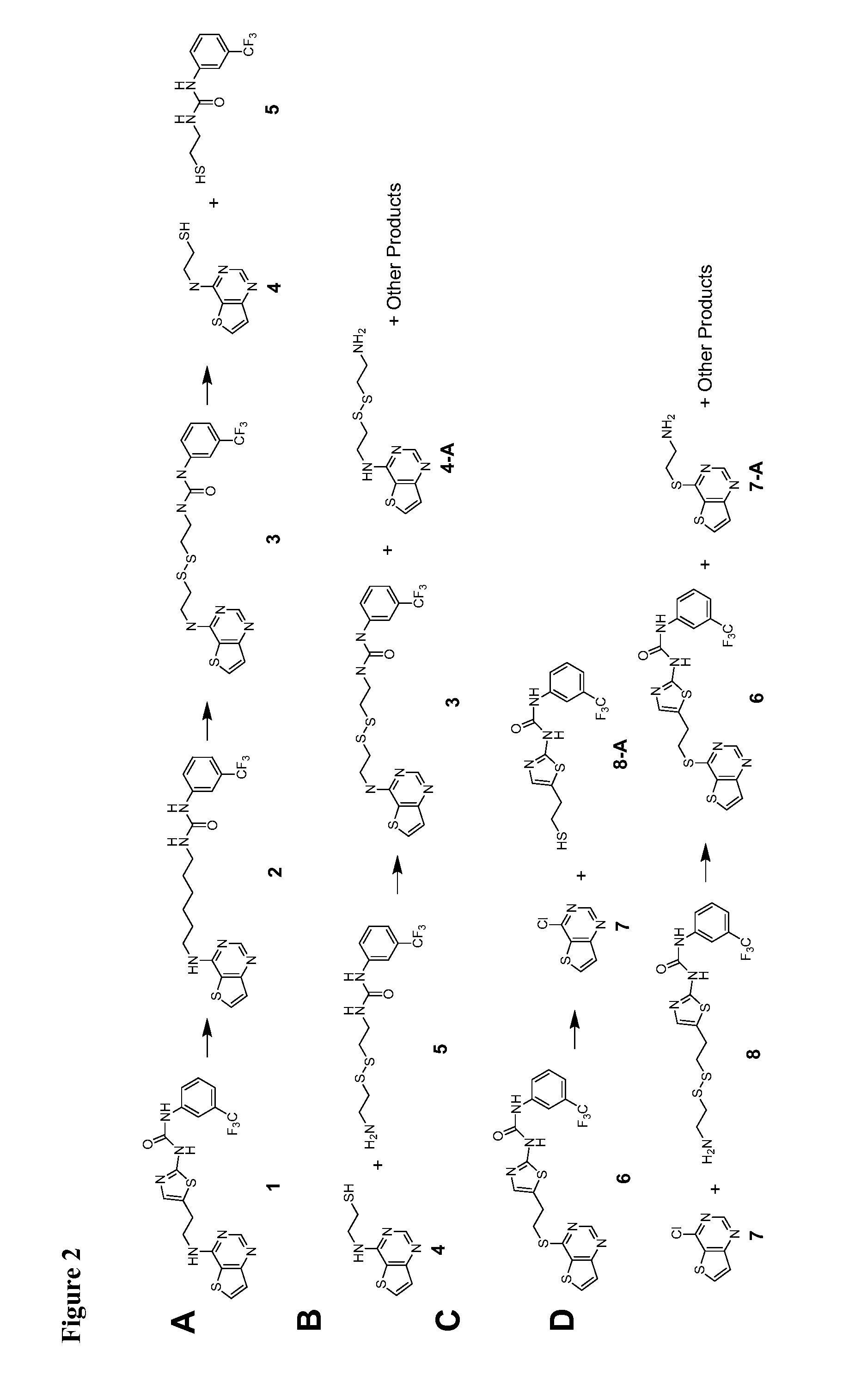Methods of chemotype evolution
a chemotype and evolution technology, applied in the field of chemotype evolution, can solve the problems of difficult to achieve in practice, high throughput screening process has not effectively accelerated the identification of new chemical entities with desirable properties, and the goal of combining two or more fragments to generate high-affinity compounds remains a significant challenge, so as to achieve rapid screening a large chemical space and low reagent cost
- Summary
- Abstract
- Description
- Claims
- Application Information
AI Technical Summary
Benefits of technology
Problems solved by technology
Method used
Image
Examples
example 1
Compound 4
[0263]
[0264]A mixture of 4-chlorothieno[3,2-d]pyrimidine (0.698 g, 4.09 mmol) and cystamine dihydrochloride (0.462 g, 2.05 mmol) was suspended in 10 mL of dry dimethylformamide (DMF), and TEA (1.14 mL, 8.2 mmol) was added. The reaction was heated under nitrogen for 2 days at 60° C., evaporated to dryness, and triturated with 50 mL of water to remove the symmetrical disulfide. The precipitate was washed with 2×25 mL water, and the combined aqueous fractions were treated with tris-2-carboxyethylphosphine hydrochloride (0.59 g, 2.05 mmol) and 7 mL 1 M sodium hydroxide to bring the solution to pH 7. After 20 min the reaction was extracted with 3×30 mL EtOAc, the combined organics were rinsed with 40 mL brine, dried over sodium sulfate, filtered, and evaporated to 0.216 g of colorless solid which was purified by silica gel chromatography (95:5 DCM : MeOH, 14.5×4.25 cm column) to yield 150 mg of white solid. This was further purified by reverse phase HPLC to yield a total of 89 ...
example 2
Compound 5
[0265]
[0266]Mono-Boc cystamine (tosylate salt, 0.349 g, 0.823 mmol) was suspended in 20 mL dry DCM and TEA (0.12 mL, 0.863 mmol) was added with stirring, followed by α.α.α-trifluoromethyl-tolyl-isocyanate (0.12 mL, 0.857 mmol). After 1 hr the reaction was evaporated to dryness, flooded with 50 mL EtOAc, rinsed with 2×25 mL 1 M NaOH, 2×25 mL 1 M HCl, 25 mL brine, dried over sodium sulfate, filtered, and evaporated to yield a yellow-brown oil. This was dissolved in 10 mL dry DCM and 10 mL TFA was added with stirring. After 30 min the reaction was evaporated to dryness, co-evaporated twice with DCM, and purified by reverse phase HPLC to yield 101 mg of Compound 5 as a colorless glass. ES (+) MS m / e=340 (M+1).
example 3
Compound 6 and Compound 8
[0267]
[0268]Intermediate 1: (2-Amino-thiazol-5-yl)-acetic acid methyl ester (0.488 g, 2.83 mmol) was suspended in 12 mL dry THF, and α.α.α-trifluoromethyl-tolyl-isocyanate (0.4 mL, 2.86 mmol) was added, followed by another 20 mL THF. After 30 min TEA (0.4 mL, 2.88 mmol) was added, and the reaction was allowed to stir for 8 hr. Then lithium borohydride (4.3 mL of 2 M stock in THF, 8.6 mmol) was added, and the reaction was allowed to stir overnight. The next day the reaction was quenched with 34 mL of 1 M HCl and 30 mL water, extracted with 3×25 mL EtOAc, and the combined organics were washed with 35 mL brine, dried over sodium sulfate, filtered, and evaporated to a yellow oil which was purified by silica gel column chromatography (95:5 DCM:MeOH, 15×4.25 cm column) to yield Intermediate 1 as a white solid (0.386 g, 1.17 mmol, 41%). ES (+) MS m / e=332 (M+1).
[0269]Intermediate 2: Intermediate 1 (0.386 g, 1.17 mmol) was dissolved in 9 mL of dry THF, and phosphorus...
PUM
| Property | Measurement | Unit |
|---|---|---|
| mass | aaaaa | aaaaa |
| mass | aaaaa | aaaaa |
| mass | aaaaa | aaaaa |
Abstract
Description
Claims
Application Information
 Login to View More
Login to View More - R&D
- Intellectual Property
- Life Sciences
- Materials
- Tech Scout
- Unparalleled Data Quality
- Higher Quality Content
- 60% Fewer Hallucinations
Browse by: Latest US Patents, China's latest patents, Technical Efficacy Thesaurus, Application Domain, Technology Topic, Popular Technical Reports.
© 2025 PatSnap. All rights reserved.Legal|Privacy policy|Modern Slavery Act Transparency Statement|Sitemap|About US| Contact US: help@patsnap.com



